Unlocking the Mystique of August's Peridot Birthstone
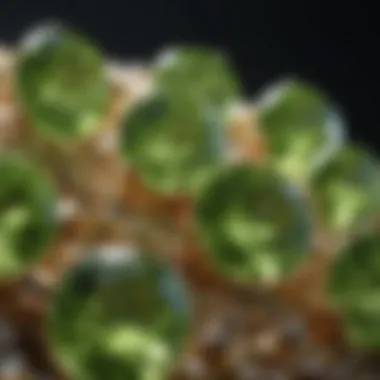
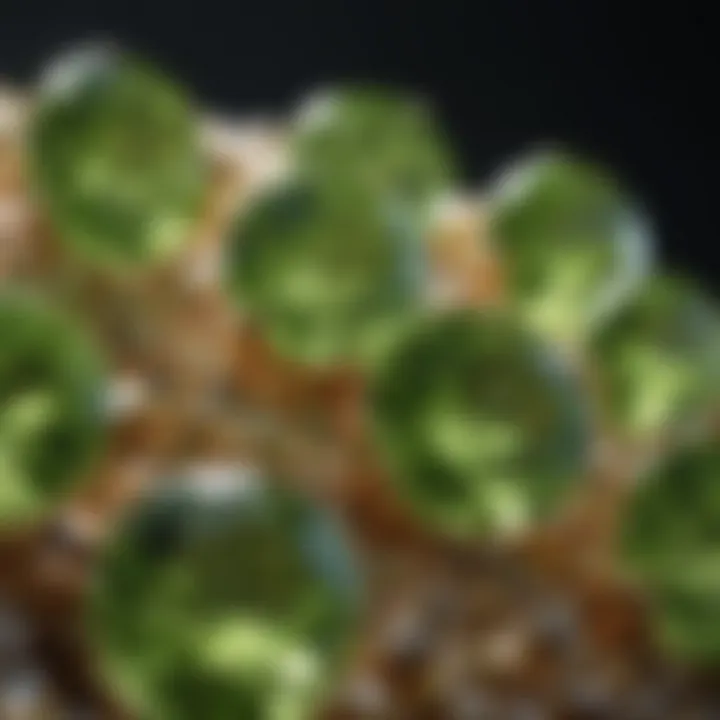
Intro
Peridot, the standout gemstone for August, captivates with its vibrant green hue and rich history. Often celebrated for its beauty, this gem holds a blend of interests for gemstone enthusiasts, collectors, and jewelry designers.
The allure of peridot goes beyond mere aesthetics. It has been cherished for thousands of years, celebrated for its unique properties and significant symbolism across various cultures. Understanding peridot is crucial, especially for those who value the historical and cultural contexts of their gemstones.
This article will delve into the essence of peridot, including its characteristics, historical significance, and how to care for and select peridot jewelry.
Through this exploration, we aim to provide a thorough perspective on the birthstone of August, enriching the understanding of its significance and appeal for all who admire this striking gemstone.
Gemstone Overview
Definition and Characteristics
Peridot is a gem-quality variety of the mineral olivine. It is typically recognized for its vivid green colors, which can range from a subtle yellowish-green to a deep forest green. This color variation is mainly due to the iron content present in the mineral. One notable feature of peridot is its strong double refraction, which enhances its sparkling appearance.
In terms of hardness, peridot ranks between 6.5 and 7 on the Mohs scale. This makes it fairly durable for jewelry use, though caution is still advised to avoid scratches or damage.
Classification of Gemstones
Gemstones can be classified as either precious or semi-precious. Traditionally, diamonds, rubies, sapphires, and emeralds are deemed precious stones. Peridot, however, is classified as semi-precious. Despite this classification, it remains highly sought after and valued for its beauty and distinctive appearance.
Historical Significance
Ancient Uses and Cultural Importance
Peridot has a rich history that dates back to ancient civilizations. It was purportedly used by the ancient Egyptians, often referred to as the "gem of the sun." They believed peridot held protective properties against evil spirits and was used in jewelry intended for the pharaohs.
In Roman times, peridot was favored by emperors and royalty. Its bright color was associated with light and warmth, believed to enhance personal insight and even provide healing powers.
Myths and Legends Surrounding Gemstones
The lore surrounding peridot is as striking as its appearance. Many cultures have ascribed various meanings to the stone. In the Middle Ages, it was thought that wearing peridot would ward off nightmares and bring the wearer good fortune. Additionally, some myths posit that peridot harnessed the power of nature, believed to protect and bring peace to its owner.
"Peridot is a stone of compassion. It is said to bring the warmth of the sun to those who wear it, fostering growth and renewal."
Closure
Peridot is not merely beautiful; it carries significant weight in historical and cultural contexts. Understanding these dimensions enhances the appreciation of this gemstone, inviting deeper insights into its allure.
As we move forward, we will explore how to select quality peridot, tips for caring for it, and current trends in the market. This journey into the world of peridot will provide valuable knowledge for all who wish to incorporate this gemstone into their collection or craft.
Prelims to Birthstones
Birthstones hold a special significance for many people around the world. They not only represent individual months but also carry unique meanings and properties associated to each gemstone. Understanding birthstones helps to appreciate their role in personal and cultural expression. This article focuses on August's birthstone, peridot, and provides a comprehensive guide to its significance, characteristics, and cultural background.
Definition of Birthstones
Birthstones are gemstones traditionally associated with each month of the year. They are often imbued with symbolic meanings, believed to offer protection, luck, or specific benefits to individuals born during that month. While the notion of birthstones has roots in ancient history, they continue to capture public interest today. For example, those born in August are connected to peridot, a distinctive stone known for its vibrant green hues.
Historical Context
Historically, birthstones can be traced back to ancient civilizations. The tradition began in biblical times, where twelve stones were mentioned in the Book of Exodus, representing the twelve tribes of Israel. Each stone later became associated with a specific month. Over centuries, the linking of specific gems to months evolved, leading to the modern list recognized in many cultures today. The importance of these stones increased in the Middle Ages when they became a popular choice for jewelry and ornamentation.
Cultural Variations
Birthstones are not uniform across all cultures. Different societies have variations of which stones correspond to particular months. In Western cultures, peridot is considered the August birthstone; however, some Eastern traditions, like those in Hindu culture, also favor different stones for the same month.
This difference illustrates how subjective and varied the meanings and associated beliefs can be. Collectors and enthusiasts often explore these cultural differences, enriching their understanding of gemstones and their significance globally.
"The fascination with gemstones transcends time and geography; each piece tells a story rooted in history, culture, and belief."
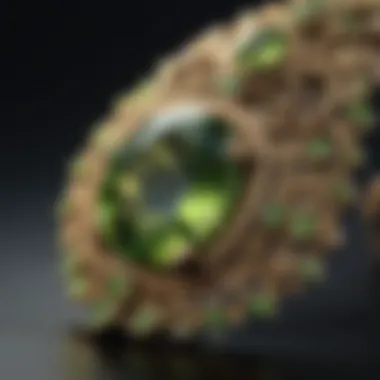
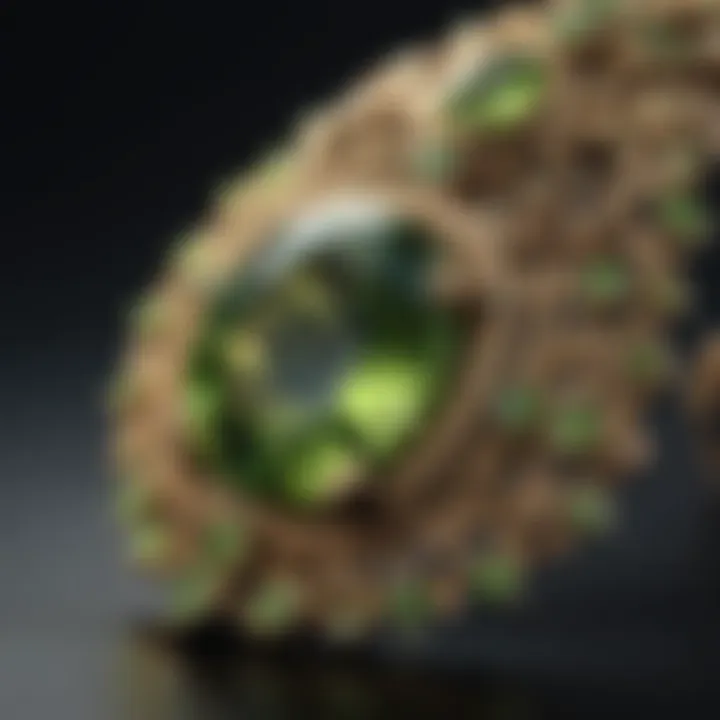
Recognizing these various perspectives enhances the appreciation of birthstones, including peridot, affirming their significance within both personal contexts and broader cultural frameworks.
The August Birthstone: An Overview
The August birthstone, peridot, holds a unique place in the realm of gemstones. It not only offers beauty but also enriches the heritage and culture associated with this time of year. This section underscores the significance of peridot as the primary birthstone for August and touches on other stones that share this month, providing a broader context.
Prologue to Peridot
Peridot is a fascinating gemstone with a vibrant green color, often associated with light and healing. It is widely recognized for its distinct hue, which ranges from yellow-green to olive-green, influenced by its iron content. The gemstone is formed deep within the Earth, and its origins can be traced back to volcanic activity. Due to its unique color and historical significance, peridot has been cherished throughout history. Ancient Egyptians referred to it as the "gem of the sun," believing it possessed protective qualities against evil spirits.
Moreover, peridot is not just beautiful but also relatively durable, registering a hardness of 6.5 to 7 on the Mohs scale. This characteristic makes it suitable for various types of jewelry, although it requires proper care to maintain its luster.
Other August Stones
While peridot reigns as the primary birthstone for August, two other stones deserve attention: Spinel and Sardonyx. Each brings unique qualities to the discussion of August stones.
Spinel
Spinel is an intriguing gemstone often mistaken for ruby or sapphire due to its color. It can be found in several hues, including red, pink, blue, and black. Spinel's key characteristic is its exceptional clarity and brilliance, making it a popular choice among gemstone enthusiasts. Unlike other stones that can be more delicate, spinel is durable, with a hardness of 7.5 to 8 on the Mohs scale.
An appealing aspect of spinel is its growing acknowledgment in the jewelry market. It is becoming increasingly favored for its beauty and rarity. Collectors appreciate its unique feature: the ability to mimic more expensive gemstones without the high price tag, providing a beneficial alternative to those seeking stunning yet affordable options.
Sardonyx
Sardonyx is a layered stone known for its striking appearance, combining shades of red, white, and brown. This gemstone has ancient origins and has been used for centuries in jewelry and decorative pieces. One key characteristic of sardonyx is its layered pattern, which makes each piece truly unique. The stone's classic appeal contributes to its popularity in various jewelry forms, from rings to pendants.
Despite its beauty, sardonyx may not be as versatile as peridot or spinel. Its darker tones could limit the design possibilities, which might be a consideration for some jewelry designers. However, its historical significance and symbolic meanings—often associated with courage and confidence—add to its allure for collectors.
In summary, peridot shines as the primary gem for August, while spinel and sardonyx complement its offerings, each contributing distinct qualities that enrich the understanding of this month’s gemstones.
Characteristics of Peridot
Understanding the characteristics of peridot is crucial for anyone interested in this captivating gemstone. These characteristics not only help to appreciate the beauty of peridot but also inform decisions regarding its purchase and care. By grasping its color, composition, and physical properties, individuals can more effectively evaluate peridot as both a gemstone and a potential investment.
Color and Composition
Peridot showcases a distinctive green hue, which can vary from light yellow-green to a more intense olive shade. This variation is primarily due to the amount of iron present in its crystalline structure. A higher iron content results in a deeper green color. It’s important to note that peridot’s vibrant color is one of the major factors that attract collectors and jewelry designers alike.
In terms of composition, peridot is a mineral of the olivine group. Its formula is represented as (Mg, Fe)2SiO4. The presence of magnesium and iron plays significant roles in defining its visual traits and overall appeal.
Physical Properties
Hardness
Peridot has a hardness rating of 6.5 to 7 on the Mohs scale. This hardness level is moderate, making it suitable for various types of jewelry, including rings and necklaces. This is a beneficial attribute for those looking to wear peridot frequently. However, it is not the most durable of gemstones compared to diamonds or sapphires. Therefore, care should be taken to avoid rough handling. This balance between wearability and care makes peridot a popular choice among gem enthusiasts.
Clarity
Peridot is often characterized by its clarity. High-quality peridot typically displays few inclusions or impurities. It’s this clarity that enhances light performance, resulting in a stunning visual effect. Many appreciate clear stones for their brilliance. However, rare instances of cloudy peridot exist, which can detract from their value. Therefore, clarity is a key factor to consider when shopping for peridot jewelry.
Cut
The cut of a peridot optimizes its visual appeal and light interaction. Common cuts include oval, round, and cushion. An expertly cut peridot can showcase its vibrant color and clarity at their best. This characteristic attracts attention from jewelers and purchasers. A well-cut peridot allows for greater sparkle and brilliance, elevating the overall design of the jewelry piece. Buyers should prioritize cut quality to ensure they receive the best possible representation of the stone's natural beauty.
Metaphysical Properties
Peridot is more than just a beautiful stone; it is often associated with various metaphysical properties. Believers say it carries a strong vibration that promotes emotional balance and well-being. Many consider it a stone of prosperity, thought to attract abundance. Additionally, peridot is said to have protective qualities, shielding the wearer from negative energies. These metaphysical aspects add a layer of significance to peridot, making it appealing not only for its aesthetic but also for its spiritual connections.
"The appeal of peridot lies not only in its captivating colors but also in its rich array of physical and metaphysical properties."
In summary, the characteristics of peridot—its color, composition, physical properties, and metaphysical associations—serve as essential elements in understanding this fascinating gemstone. They provide insights that help both collectors and consumers make informed decisions.
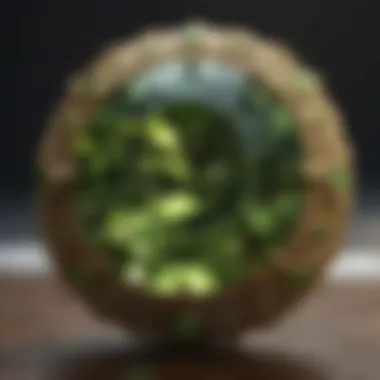
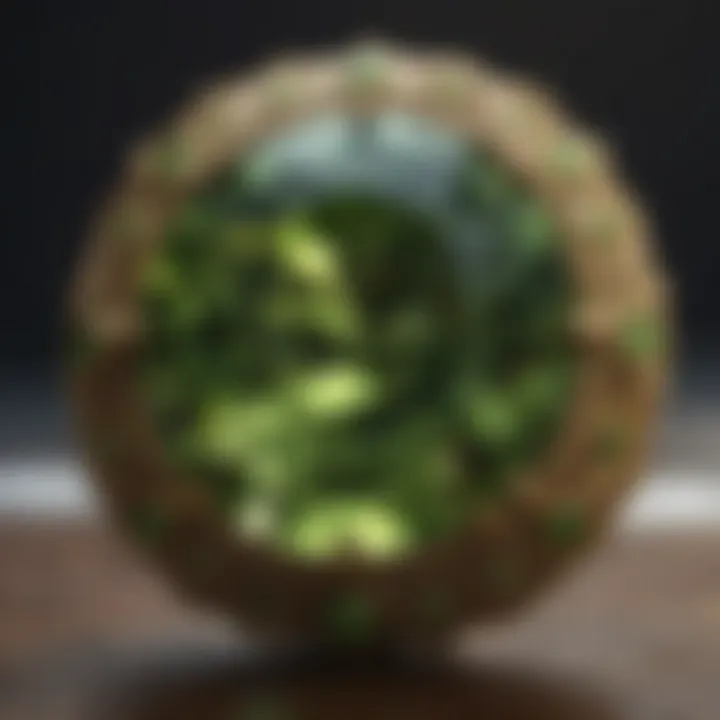
Historical Significance of Peridot
Understanding the historical significance of peridot adds depth to its appreciation. This gem has been cherished for centuries. It has ties to ancient civilizations, which valued it for both beauty and symbolic meanings. Its enduring nature throughout history reflects its importance across cultures.
Ancient Civilizations
Egyptian Usage
Peridot held a prominent role in ancient Egypt. Egyptians believed this gemstone had protective qualities. They often adorned their jewelry with peridot, viewing it as a talisman against evil spirits. Among notable uses, peridot was favored in royal regalia and tomb artifacts. This practice emphasized its perceived power and status. The vibrancy of peridot also complemented the gold typically used in Egyptian adornments.
A key characteristic of Egyptian usage was the stone's brightness, which was thought to resemble the sun. This solar association made peridot a popular choice for high-status individuals. Notably, it was often associated with the goddess Isis, symbolizing fertility and abundance. The benefits of this practice reflect how peridot was not just ornamental but also a spiritual safeguard. Additionally, its unique olive-green hue set it apart from other gemstones of the era, giving it distinct advantages.
Roman Beliefs
In ancient Rome, beliefs surrounding peridot were also notable. Romans viewed the stone as a symbol of light and prosperity. They associated it with various deities, including Jupiter, enhancing its status further. Roman jewelers crafted intricate pieces that featured peridot prominently, making it a symbol of wealth.
One distinct feature of Roman beliefs was the idea that peridot would illuminate the wearer, banishing fears and enhancing relationships. Such symbolism made it a favored choice among the elite. Its popularity grew due to its perceived connection to harmony, leading to a** surge in demand** for peridot during this period. However, the stone was not only celebrated for its aesthetic but also as a means of social status and cultural identity.
Myths and Legends
Throughout different cultures, myths and legends surrounding peridot add further significance to the stone. Many tales depict it as a guardian against dark omens. Different societies attributed various virtues to this gemstone, and these stories have contributed to its ongoing allure. From offering protection during travels to fostering positive energy, the narratives surrounding peridot continue to resonate today.
Cultural Symbolism of Peridot
Peridot, with its vibrant green hue, has rich cultural symbolism across various societies. Understanding its significance can greatly enhance one’s appreciation for this unique gemstone. Culturally, peridot has been viewed not just as a beautiful accessory but as a talisman that carries meanings aligned with protection, love, and harmony. These associations make it particularly appealing for those who value jewelry not just for aesthetics, but also for the emotional and spiritual connections it embodies.
"In many cultures, gemstones like peridot are believed to possess mystical properties that influence the wearer’s circumstances."
Symbol of Protection
The symbolism of protection linked to peridot has deep roots in various ancient civilizations. For instance, ancient Romans believed that wearing peridot could shield one from evil spirits. This stone was often used to craft protective amulets and talismans. In this view, peridot is not merely a adornment but a protective entity that guards the wearer against negative energies.
In modern times, many people still believe in the protective properties of peridot. Wearing peridot is thought to bring a sense of safety and well-being. This belief has translated into the jewelry realm, where people gift peridot pieces to loved ones, symbolizing their wish for protection and peace.
Association with Love and Harmony
Peridot also carries associations with love and harmony. Many cultures regard this gemstone as a symbol of affection. In ancient Egypt, peridot was known as the 'gem of the sun,' representing light, life, and love. This connection to love extends to relationships, where peridot is thought to promote harmony between partners and foster understanding in friendships.
In contemporary times, those who wear peridot often do so for its reputed ability to encourage peaceful interactions. This means that it is frequently gifted on special occasions, such as anniversaries and weddings, to symbolize enduring love and relationship strength.
In summary, the cultural symbolism of peridot encompasses a rich tapestry of meanings, primarily focusing on protection, love, and harmony. For gemstone enthusiasts, these attributes offer an added layer of significance, making peridot an appealing choice in both personal adornment and sentimental gifts.
Selecting Peridot Jewelry
Choosing peridot jewelry requires thoughtful consideration of various factors that directly affect its appeal and value. This section aims to highlight essential elements to evaluate while selecting peridot pieces. Understanding these will enhance the overall experience as well as ensure satisfaction in the long term.
Factors to Consider
Color
Color is one of the most important characteristics of peridot. The best examples exhibit a vibrant green with a slight yellowish hue. This specific shade is often sought after due to its brightness and unique warmth. Light and dark variations can affect the beauty and value of the stone. When choosing peridot jewelry, a bright green gem can be very appealing. However, gems that lean too much toward yellow may not be as desirable. It is essential to pick a stone that reflects your personal taste, as color plays a pivotal role in the overall aesthetic. Having an informed choice can increase satisfaction and enjoyment of the piece.
Clarity
Clarity refers to the presence of internal flaws or inclusions in the gemstone. For peridot, higher clarity stones are often regarded more highly. A clean stone can exhibit more brilliance and brightness, making it more visually striking. On the other hand, stones with noticeable inclusions may be more budget-friendly. These inclusions can create interesting patterns but may detract from a pure look. When selecting peridot jewelry, consider the balance between clarity and cost, keeping in mind that a clearer stone may be worth the investment.
Cut
The cut influences how well light travels through the stone, which can affect its sparkle. Popular styles include standard round cuts and fancy shapes that enhance the unique features of peridot. A well-cut stone increases the probability of achieving greater brilliance and fire. Choosing a cut that highlights the characteristics of peridot is crucial. Remember that while specific cuts may appeal aesthetically, they can also influence the stone's market value. A thoughtful consideration of cut can lead to finding a piece that is not only beautiful but is also a smart investment.


Where to Buy
When it comes to purchasing peridot jewelry, multiple avenues are available. Each option has unique features that may appeal to different types of buyers.
Jewelry Stores
Jewelry stores provide a personal experience when buying peridot. A customer can view pieces in person and assess color, clarity, and cut directly. Skilled jewelers can also offer insights into care, and selection and may provide certifications for quality assurance. The main advantage is the hands-on experience and expert guidance. However, local stores may have limited selections compared to online options, and prices might be higher due to overhead costs.
Online Retailers
Online retailers have transformed the jewelry-shopping landscape. They offer a wide variety of styles, often at competitive prices. Many sites provide detailed descriptions, images, and customer reviews, making it easier to compare various options. The convenience of shopping from home is appealing to many buyers. However, purchasing online may come with the disadvantage of not being able to physically examine the jewelry. It’s vital to buy from reputable sources and consider return policies, so you can ensure satisfaction with your choice.
Caring for Peridot
Caring for peridot is essential to preserve its beauty and longevity. As a gemstone that symbolizes lightness and renewal, it is important to maintain its clarity and shine. Proper care helps to retain its stunning green hue and protects it from potential damage. This section focuses on key aspects of caring for peridot jewelry.
Cleaning Practices
Regular cleaning is crucial for peridot to keep its appearance vibrant. Dust, oils, and dirt can accumulate on the surface, dulling its luster. Here are some recommended cleaning practices:
- Use mild soap and water: Mix a few drops of mild soap with warm water. Use a soft cloth or a toothbrush with soft bristles to gently scrub the peridot. Ensure you do not use abrasive materials to avoid scratches.
- Avoid harsh chemicals: Chemicals in cleaners can damage the stone. Products such as bleach or ammonia should be avoided. It is best to stick with natural cleaning solutions to preserve the integrity of the gem.
- Post-cleaning rinse: Rinse the peridot thoroughly with clean water to remove any soap residue. Make sure it is completely dry before storing it away.
Cleaning peridot regularly not only enhances its appearance but also prolongs its life, making it a worthwhile part of gemstone care.
Storage Recommendations
Proper storage of peridot is as vital as cleaning. The way you keep your jewelry can prevent scratches and other damages. Here are some storage tips:
- Separate storage: Store peridot pieces separately from other jewelry to avoid contact with harder stones like diamonds or sapphires. This keeps the surface scratch-free.
- Use a soft pouch or box: Wrap peridot in a soft cloth or place it in a padded box. This additional layer of protection will cushion the stone against impacts and environmental changes.
- Avoid extreme conditions: Store peridot away from direct sunlight or extreme temperatures. Such conditions can affect its color and overall stability.
Effective cleaning and secure storage methods significantly contribute to maintaining the allure of peridot, the birthstone of August. By taking these steps, owners can ensure their peridot jewelry remains as stunning as the day it was purchased.
Market Trends for Peridot
Understanding the market trends for peridot is crucial for enthusiasts, collectors, and investors alike. The gemstone's appeal is not just rooted in its beauty but also in its market dynamics. Analyzing current market conditions can aid potential buyers in making informed decisions while providing sellers with insights to price their products competitively.
The demand for peridot can fluctuate due to various factors, including fashion trends, marketing efforts, and economic conditions. Recognizing these trends can help assess the stone's longevity in the market. With a rise in consumer awareness about gemstones, peridot has gained traction, especially among younger audiences seeking distinct and colorful stones in jewelry.
Current Market Prices
Market prices for peridot can vary significantly based on several factors. These include size, color, clarity, and the stone's origin. A high-quality peridot with vibrant green hue generally fetches a premium. Currently, peridot prices can range from $50 to $400 per carat, depending on its quality and how it is set in a piece of jewelry.
- Factors influencing price:
- Size: Larger stones are typically more valuable.
- Color: The most desirable shades are vivid green, often compared to lime green or olive green.
- Clarity: Inclusions can lower a stone’s value.
- Origin: Peridot from certain geographical locations may carry a higher price tag.
Investment Potential
Investing in peridot presents both opportunities and risks. While the gemstone is not historically regarded as a primary investment like diamonds or sapphires, its unique characteristics can make it appealing for diversification within a gemstone portfolio. Additionally, the surge in popularity of peridot among millennials can signal potential appreciation in value over time.
Several considerations should be taken into account:
- Market fluctuations: The gemstone market can be volatile, but peridot's growing popularity might mitigate risks.
- Quality: Higher quality stones are more likely to appreciate in value.
- Collectability: Limited editions, specific cuts, or unique origins can drive demand.
Investment in peridot should be approached with careful research, focusing on quality and the stone's unique features.
Ending
The conclusion of this article serves as a fitting summation of the multifaceted nature of peridot, the recognized birthstone for August. Understanding peridot encompasses various elements—its striking physical characteristics, its historical significance, and its cultural implications. From ancient civilizations to modern jewelry markets, peridot holds a tight grip on both sentiment and value.
Recap of Peridot Significance
In reviewing the significance of peridot, we consider several key points. First, its vivid green color is not only eye-catching but carries symbolic meanings of protection and harmony. The stone has a rich history, as it was esteemed in ancient Egypt and carried religious significance for Romans. Many believe in its metaphysical properties, which denote healing and emotional balance. When choosing jewelry, understanding these aspects can greatly enhance the value of a piece, both personally and financially. Peridot stands out in the gemstone world, not just for its beauty, but also for the stories behind it and its place in various cultures.
Final Thoughts on August Birthstone
As we conclude, the importance of considering peridot reaches beyond aesthetic appeal. For gemstone enthusiasts and collectors, the choice of peridot can highlight a connection to tradition and elegance. Furthermore, it can be a symbol of personal growth and emotional well-being. Whether worn or given as a gift, peridot is imbued with meaning. Its market presence underscores a mix of investment potential and collectible beauty. As the birthstone for August, peridot serves not only as a reminder of one's birth month but as an emblem of deeper significance in a rapidly evolving world.







